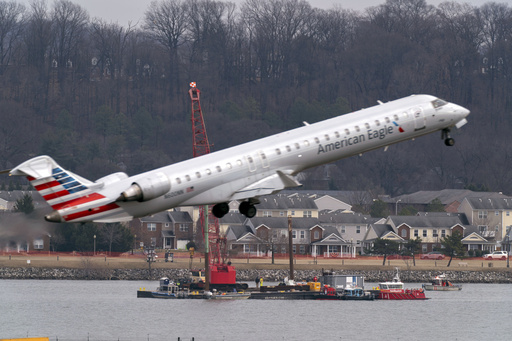President Donald Trump spoke on Thursday about the recent tragic incident involving a passenger jet and an Army helicopter, attributing the deadly mishap to what he described as an “obsolete” air traffic control computer system. He expressed his intention to implement a new system to enhance aviation safety in America.
During an address at the National Prayer Breakfast held at the U.S. Capitol, Trump recounted the event from January 29, which saw an American Airlines flight departing from Wichita, Kansas, collide with an Army helicopter near Ronald Reagan National Airport, resulting in the loss of all 67 lives on both aircraft.
Initially, Trump had attributed the accident to issues stemming from diversity hiring initiatives, but on Thursday, he shifted the focus to the outdated computer infrastructure that air traffic controllers currently utilize. He emphasized the need to design a brand-new system specifically for control towers, rather than attempting to patch together the existing, inefficient framework.
Trump stated that the federal government invested billions in maintaining an antiquated system rather than pursuing modern technological advancements. He mentioned how, on his private jet, he relies on a foreign system for landing, citing the inadequacy of the domestic infrastructure as the reason.
Transportation Secretary Sean Duffy and entrepreneur Elon Musk took to social media, announcing that Musk’s team at the Department of Government Efficiency would aid in the speedy enhancement of the nation’s aviation safety protocols.
Since the mid-2000s, the Federal Aviation Administration (FAA) has been engaged in efforts to modernize air traffic control through its NextGen program, initiated in response to concerns over increasing air travel demands. A law enacted by Congress in 2003 prompted these critical upgrades.
Geoff Freeman, leader of the U.S. Travel Association, praised Trump’s commitment to replacing the current systems, aligning with industry calls for improved technology and workforce investment.
Federal officials have raised alarms regarding an overburdened and under-resourced air traffic control network, especially following a series of alarming close encounters between aircraft at various U.S. airports. Factors contributing to staffing deficits include inadequate salaries, extended work hours, rigorous training requirements, and obligatory retirements.
Trump posited that had there been a more contemporary system in place, alerts would have been triggered when the Black Hawk helicopter, participating in a training session, converged in altitude with the passenger plane.
However, a report from the FAA following the incident indicated that the air traffic controller received an alert regarding the potential collision when the aircraft were still a mile apart. The controller queried the helicopter about its visual contact with the plane and instructed it to maintain a position behind the jet, to which the helicopter confirmed it had the plane in sight.
In a bid to prevent future incidents, the FAA announced its intent to ensure that helicopters and planes do not share airspace over the Potomac River, with most helicopter flights restricted in that region. In instances where presidential or police helicopters must navigate through this area, a no-fly zone for airplanes will be enforced.
An initial line of inquiry in the investigation focuses on establishing the altitudes of both aircraft. The flight recorder of the jet has indicated an altitude of around 325 feet, while information from the airport’s control system suggests the helicopter was operating above its designated flight ceiling of 200 feet.
To acquire more precise data, investigators need access to the wreckage of the submerged helicopter. Officials from the U.S. Army Corps of Engineers reported that all major parts of both the helicopter and the jet have been retrieved from the river and will be examined by NTSB investigators at a secured location. Teams will continue to remove smaller debris from the water over the next ten days, completing their efforts by February 16.
Col. Francis Pera, Commander of the Corps Baltimore District, stated that efforts would persist until they ensure the safety of navigation in the river and recover vital evidence for the relevant authorities.
This incident marks the deadliest aviation accident in the United States since November 12, 2001, when a jet crashed into a residential area in New York City shortly after takeoff, resulting in the deaths of all 260 people aboard and five individuals on the ground.
Concerns arose following the crash over Trump’s plans to reduce the size of the federal workforce, potentially exacerbating the shortage of air traffic controllers if some opted for voluntary resignation. However, controllers were informed by their union that certain FAA positions, including theirs, would be exempt from such offers.
The National Air Traffic Controllers Association clarified in a communication to its members that additional roles could also be exempted based on national security and public safety obligations. The union had recommended earlier that its members reject the resignation offers, which were extended just a day before the unfortunate collision.




